Everything you Need to Play Electric Guitar: A Guide – Guitar Inside Out
When thinking about taking up a musical instrument many people overlook everything that is involved. Some instruments you can just buy and get started straightaway. But others, like the electric guitar, require some extra accessories and bits and pieces before you can properly begin playing.
So exactly what do you need for an electric guitar? What are the fundamentals you need to play a guitar?
Well the minimum you will need is a guitar, an amp, a cable and pick. There are some extra bits you will probably want as well like a strap, tuner, case and more. But to get started those very basic 4 things will allow you to begin playing the electric guitar.
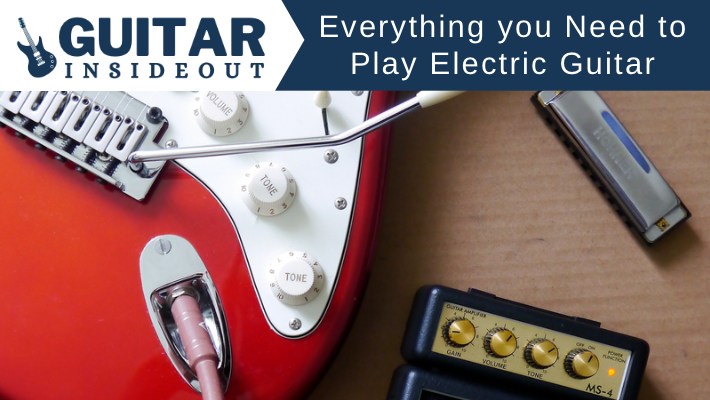
If you’d like a bit more detail though and are not completely sure what you will need before you can start playing your guitar then we’ve got you covered. This guide will look at all the essentials as well as a few things you don’t necessarily need but might want anyway.
What you Need to Play Electric Guitar
The following gear is the minimum you will need to play the guitar. You won’t be able to get the full experience without them.
A Guitar
Obviously, you can’t play the guitar without actually having a guitar. So that’s the first step: acquire a guitar.
Buy one, rent one, inherit one. Maybe don’t steal one. But get yourself an electric guitar.
We won’t go into any really depth of which guitar to get or how to choose one. But the basics are:
- Don’t spend big if you’re a beginner. You might end up hating it and have then wasted a huge amount of money on something you won’t ever use.
- Try before you buy. Going to a guitar store and playing different guitars is always recommended. Even if you’ve never played an instrument or picked up a guitar before it’s still a good idea. Why? Because guitars vary in size, weight, shape, neck width, sound etc. You might not be able to play them yet but you will definitely notice the difference. And some will feel more comfortable to hold than others, will have necks that fit your hands better etc. So trying in person is the best way to buy a guitar.
- Slightly contradicting the previous point: you can buy online from somewhere like Amazon because they have such a good returns policy. You can try a guitar out send it back if you don’t like it. Still, if you’re going this route do a lot of research before buying.
- Online often has better deals and more options for things like the color. So trying in store but then buying online is also a good way to go.
- Looks aren’t really important. But at the same time if the fact that it appeals to you visually is going to make you more likely to pick it up and play it then getting a guitar that you really like the look of becomes very important. Be honest and don’t worry about it sounding a bit shallow – are you going to play your guitar more because you think it looks good? If so then buy with that in mind.
- Do research first. There are so many useful resources out there it’s a good idea to read up on guitars first: try websites, forums, Reddit etc.
- Stick to a well known brand. It’s not full proof but you’re far more likely to get a decent, well made entry guitar from the likes of Fender or Ibanez’s. If you buy a brand no one has ever heard of there’s a high probability it’ll be terrible – poorly made, awful action (how high the strings are from the fretboard), and sound cheap.
If you’re a total beginner than you can’t really go wrong with a Squier Stratocaster or Telecaster. I’ve still got my 2003 Squier Strat and whilst its not the best guitar I own it was what I learnt on. They absolutely won’t let you down.
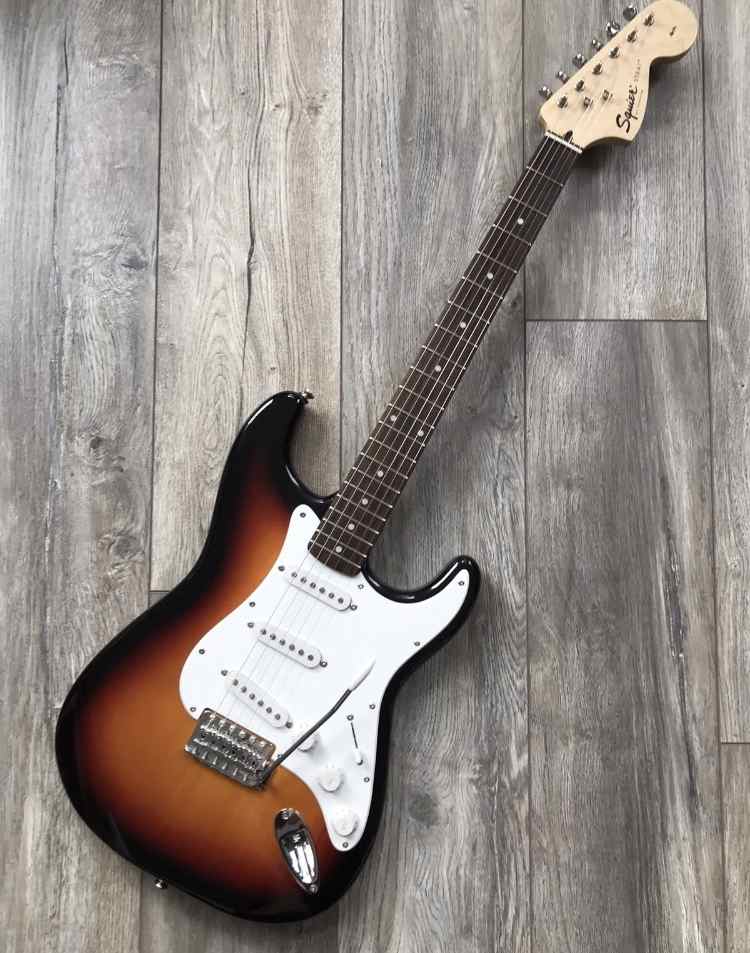
If you’re a female or child beginner then have a look at our guide to the Best Guitars For Female Beginners
An Amplifier
For the most part you will want an amp if you’re playing an electric guitar. In fairness you don’t need an amplifier to play the electric guitar – a lot of people practice unplugged because of noise constraints: living in an apartment, don’t want to annoy the neighbors etc.
But if you want to sound anything like your favorite bands and artists then you will want an amp. It’s also important to practice and play amplified at times because you need to get familiar with string muting, the noise from your fingers when changing strings and chords, and more.
There is an alternative to an amp though: playing through your computer. You will need something called an audio interface to go between your guitar and laptop or PC though.
That might be a dedicated interface or something like a multi effects pedal. Whatever it is though it makes it possible to play through your computer which is becoming increasingly popular.
I think playing with an amp is a lot more straightforward though!
If you’re not sure which amp to get or how to decide try our guitar amplifier buying guide
A Cable
You can’t expect your guitar and amp to just magically to connect with each other. They need something to link them together.
That would be a cable. So when you pick or strum the strings the pickups can convert it into an electrical signal and send it to the amplifier which amplifies it.
Without a cable you’ve got an instrument and an amplifier that have no connection. They’re like strangers.
Even if you choose to go the non-amp route and use your computer then you’ll still need a cable.
Cables can also affect the sound and tone of your guitar. A poor quality cable could cause unwanted noise and feedback.
So it’s probably a good idea to get a cable from a well known brand that you can rely on. Both in terms of its audio quality but also build quality – you don’t want it breaking on you.
I use Planet Waves American Stage Cables. They do the job and do it well without needing to spend huge amounts.
A Tuner
Playing in tune is absolutely essential. If your guitar isn’t in tune everything you play will sound wrong and just awful.
But as a beginner you aren’t going to be able to tune your guitar yourself. So you’re going to need either an electronic tuner, tuning pedal or even a tuner app on your phone.
Tuning apps are free and easy to use. You can download and be using one within a couple of minutes.
If you’re going to be playing live then you will probably want to get a tuning pedal. They range in prices from very affordable ones from lesser known brands through to the industry standards like a BOSS tuner.
The BOSS TU pedals are great, I have one, it’s virtually indestructible and works perfectly.
But if you’re just getting started then a tuner app will be absolutely fine. Fender do a really good one that comes with loads of different tunings, a metronome and more. Guitar Tuna is very popular too and works really well.
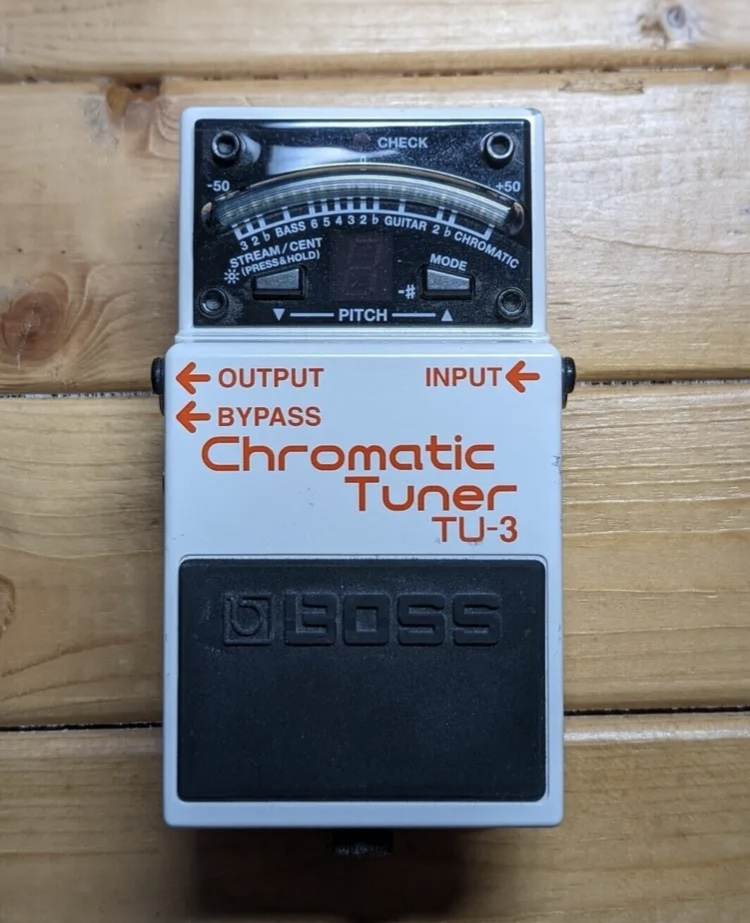
A Pick
Whilst this isn’t strictly necessary, and there are a few famous electric guitarists who don’t use a pick (Mark Knopfler, for example), most people will start with a plectrum.
It’s how the vast majority of songs are played on the electric guitar so it’s a good idea to get familiar with using one.
There are a ridiculous amount of picks for you to choose from. They vary in shape, size, thickness, color (that last one isn’t so important).
I personally started with Dunlop Tortex 0.5mm, which are the red ones. I’ve since moved to Dunlop Jazz III’s but they’re smaller and thicker so may be a bit more awkward for beginners.
The best idea is to buy one or two of different thickness and shape then try them out (don’t worry, they’re cheap). You’ll soon work out which one suits you and feels right as you play.
Strings
Most guitars come already strung. But using the strings your guitar comes with means you don’t get to choose the gauge or brand of string.
When you’re first learning to play the guitar having a thinner or lighter string gauge can help: it’s less painful to hold down, your calluses will hurt less as they develop, and doing things like barre chords will be easier.
Plus the strings that come on guitars from the factory are often not very good. It might be a better idea to buy a pack of Ernie Ball or Elixir strings and switch them.
It’ll give you an excuse to practice restringing your guitar as well. Which is something you will want to learn to do quite early on as you’re bound to break a string at some point.
A Strap
A strap is pretty essential. Most people learn guitar sitting down and so you might think you can get away without one.
But it’s a good idea to practice standing whilst you play as well.
If you have any intention of playing live you’ll need to be comfortable playing whilst standing up. And even if you don’t intend to it’s still better to be used to playing standing up.
Straps don’t need to be special. You can pick up a cheap one made from fairly regular materials.
When I got a Les Paul, which is a notoriously heavy guitar, I paid a bit extra and bought a fancier, leather strap. This was to make playing the weightier guitar easier and put less strain on my back.
That might be something you consider at some point but to begin with a normal strap is going to be more than good enough.
A Way to Learn
Once you’ve got all the necessary gear it’s time to begin playing. But where do you start?
Learning by yourself can be tricky. You could just go ahead and randomly hit the strings and hope it eventually sounds good. Or attempt to play along with songs you like.
But honestly you’re not likely to get very far. You need some sort of structure to follow.
That might be a book, an online course, YouTube videos, a teacher etc. Whatever it is having some guidance and help to begin learning the basics is essential.
Otherwise you’ll probably flounder around for a while before giving up through frustration. And we don’t want that.
Fender Play is an excellent app and tuition tool that will give you structure and help you learn in a fun way.

Try the Fender Play Two Week Free Trial: Step-by-Step Online Lessons for Guitar, Bass & Ukelele.
What isn’t Necessary But you Still Might Want
There are some bits and pieces that aren’t absolutely necessary but could still help you as you learn. Or you might just want them, regardless of how useful they are.
A Case or Gigbag
Storing your guitar properly is important. A case is probably the easiest option and will do a good job.
But it doesn’t have to be a case or gig bag. A guitar stand is also a good choice. Or wall hanger. Putting it in your closest will probably do the job as well!
So don’t feel pressured into getting an expensive case. Most of my guitars lived in cheap gig bags until I got a Hercules rack for them.
Strap Locks
Strap locks are clever little inventions. The name is self explanatory: they lock your strap.
You’ll probably find out quite quickly that regular straps have a habit of coming off your guitar. Which if you’re playing live or just practicing standing up is far from ideal.
You’ve either got to hope you have lightning fast reactions and catch your guitar as it falls.. or it’s going to hit the ground. And potentially break.
But if you’ve invested in some strap locks you don’t have to worry about that happening! In fact you can play safe in the knowledge your guitar is tightly connected to its strap and won’t be falling.
Which, considering how reasonably priced strap locks are, is worth it for the peace of mind.
Try these Dunlop Strap Locks that are very popular and work perfectly.
A Capo
A capo is a small device that attaches to the neck of your guitar and holds down all the strings at whichever fret you’ve placed it. It’s the equivalent of taking your finger, laying it across all the strings and then leaving it there.
This is used to change the key of a song and still use open chords or to simplify playing barre chords. If that doesn’t make sense yet it will do soon, I promise.
Whilst a capo is more popular with acoustic guitarists it’s still used with the electric too. And considering they cost next to nothing there’s no reason not to get one. Even if you only use it once in a while.
I have a Kyser Capo that I really like but I’ve had a few different types and they’ve all done a decent job.
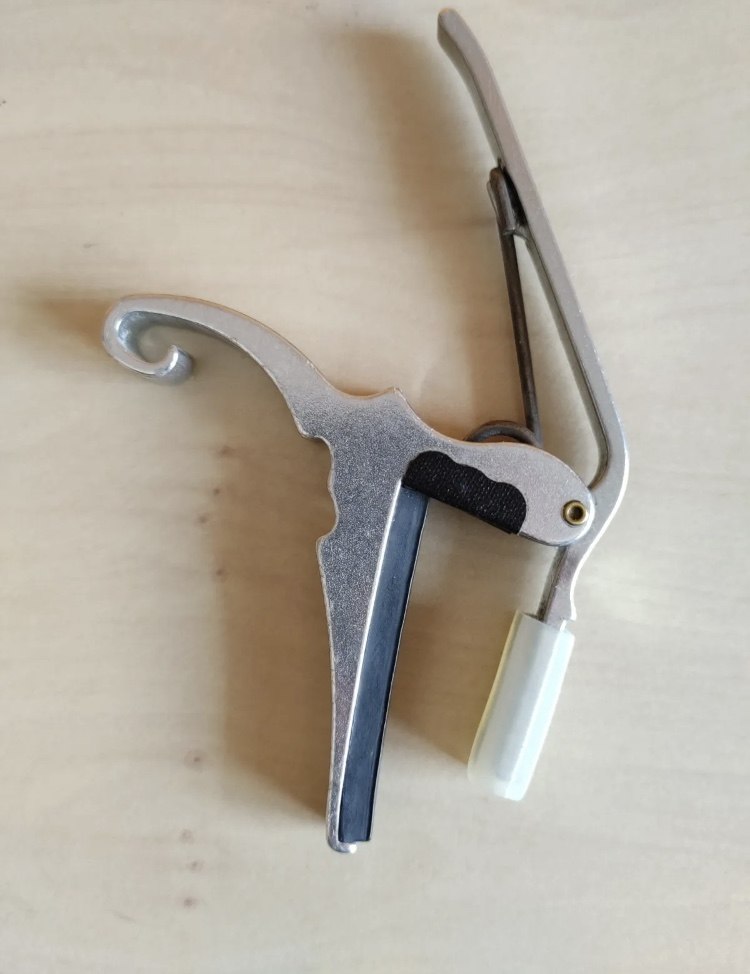
A Guitar Setup
If you’re lucky when you buy a new guitar it comes setup perfectly. No string buzz, low action, straight neck etc.
But not all do. Plus everyone has a different idea of what makes a guitar easy to play is.
Some people love their strings to be a thin as possible with the lowest action. Others prefer thicker strings with a high action. And many are somewhere in between.
So a lot of guitars are shipped or sold with a fairly generic setup to try and cater to everyone. And some just arrive barely playable!
Which is why you might want to take yours to a luthier or guitar tech who can do a full setup.
A lot of people don’t think it’s worth it but playing a poorly setup guitar is terrible. It will hold you back and make your progress much, much slower.
So while it’s not necessary it is something to you might want to consider.
Lessons
Paying for actual lessons, be that in person or virtual, isn’t strictly necessary. On the whole my gut tells me that those who take lessons probably learn faster.
But there are so many self taught guitarists out there and you can definitely reach an extremely high level learning on your own.
Especially seeing as the internet has revolutionized the way people learn guitar. YouTube has thousands of quality tutorial videos, places like JustinGuitar.com offer a brilliant free beginners course.
You can sign up for more in depth and intermediate courses all over the web and there are some great apps from the likes of Fender, Yousician etc.
Honestly, I don’t want to sound like an old man, but if you’re learning the guitar in the age of the internet you have it so easy! The difference between nowadays and before the internet is huge.
So if you can’t afford to pay for lessons or don’t like the idea of them then take advantage of everything that is out there.
What you DON’T Need
You really don’t need the following things to play the electric guitar. You might be tempted or feel like you’re missing out but they’re really not that important.
Pedals
Guitar pedals are great, don’t get me wrong. They can open up a world of new possibilities with your playing and let you recreate some iconic sounds.
But they’re definitely not essential. Lots of guitar based music is just a guitar into an amp, no pedals or effects.
You can get into the world of pedals when you’ve been playing for a while and feel more confident. But to begin with it’s a much better idea to focus on learning the basics and getting comfortable with playing.
Pedals will just end up being a distraction that you’ll fiddle with instead of actually learning and practicing.
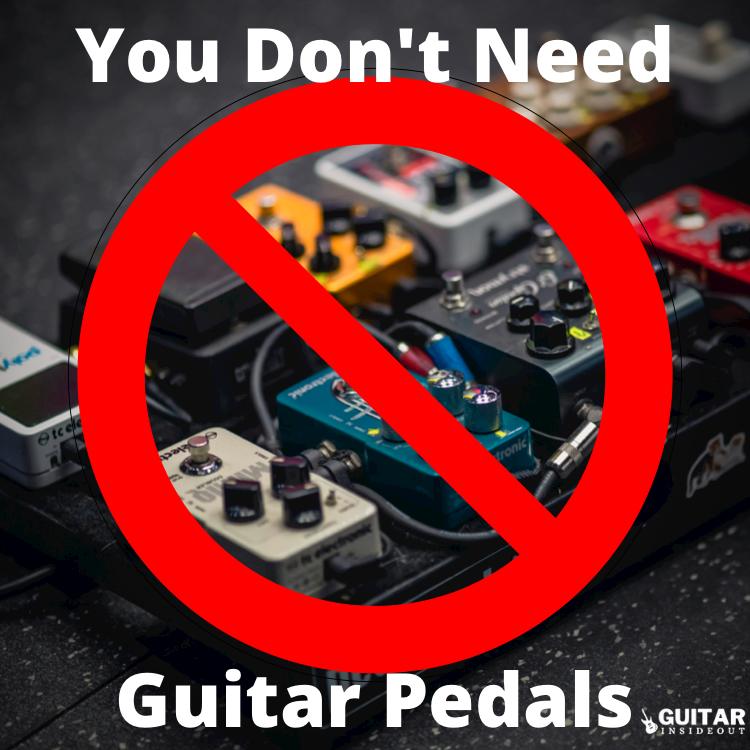
An Amp Cover
I wrote about my experience with whether I need an amp cover and came to the conclusion I did not. And I think that’s the same for beginners too.
An amp cover or case is really important if you’re playing gigs and moving your amp regularly. Or if you’ve got a destructive pet that is likely to ruin your amplifier by tearing or peeing on it.
But apart from that they’re not really necessary. You can protect your amp from dust without a cover and the worry around dust doing damage is a bit over exaggerated anyway.
The Best Gear
You don’t need to spend a huge amount to buy the best guitar or top amp before learning. Most people begin with a starter or entry level guitar and amp.
There’s a good reason for this. Firstly you might not like learning guitar. You don’t want to have spent loads on a top of the range guitar or amp to discover within a few weeks you don’t enjoy playing it.
Secondly, entry level gear is so much better than it was 10 or 20 years ago. There are many examples of “cheap” guitars being almost as good as guitars double or triple the price.
As you grow and begin to take it more seriously you can invest in a better amp or guitar. But when you’re starting out it’s a much better idea to save your money for the time being and stick with
Conclusion
Hopefully you now have a better idea of what you need to play the electric guitar. The main thing is to get those few bits of gear you need and then start playing!
Don’t waste time buying too much or fiddling with the unnecessary gadgets. Just get stuck in and start playing!















![Toni Kroos là ai? [ sự thật về tiểu sử đầy đủ Toni Kroos ]](https://evbn.org/wp-content/uploads/New-Project-6635-1671934592.jpg)


